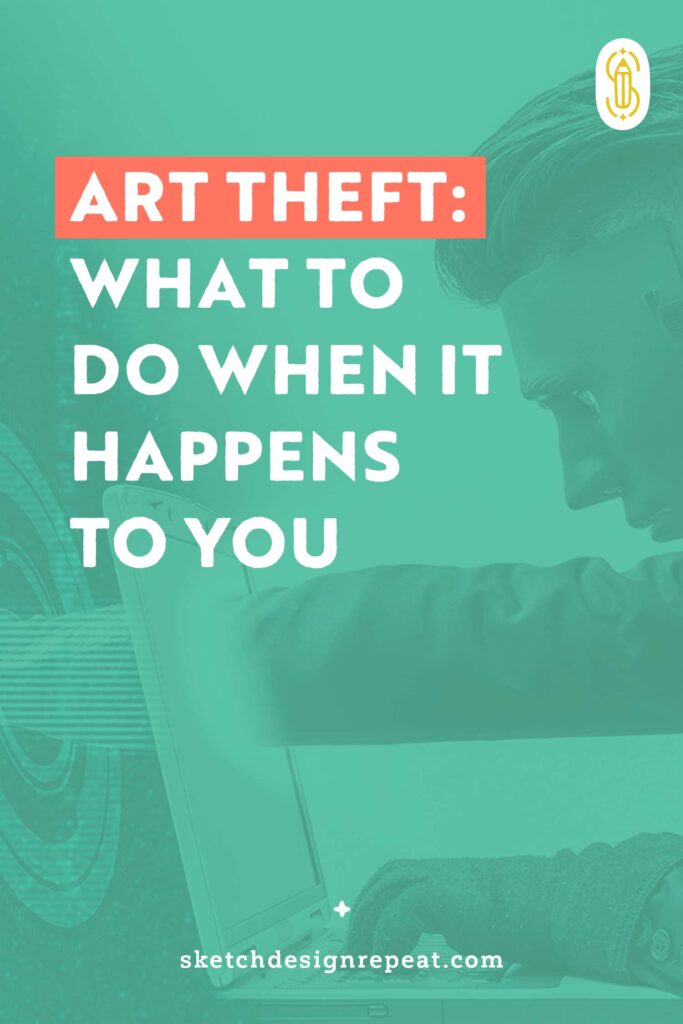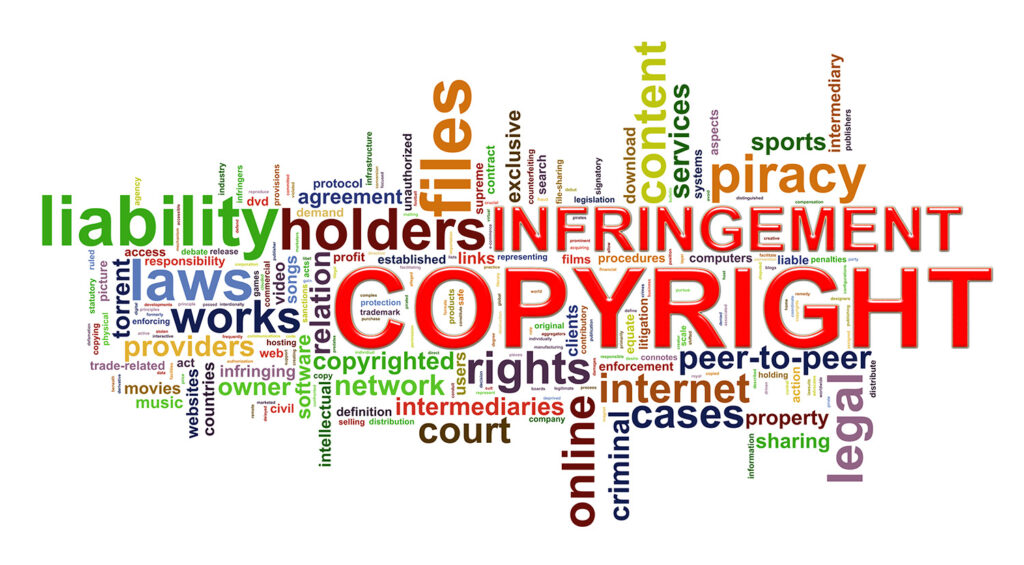According to our 2022 Surface Design Industry Survey, almost fifteen percent (15%) of the 689 survey participants had their artwork stolen in 2022. The issue of art theft, also called visual plagiarism, used to be an “if it happens” issue.
However, with the growth of social media posts, artificial intelligence scraping, and other art data mining, the issue of art theft has blossomed into a “when it happens” issue. Accordingly, the first lesson to be learned about handling the theft of your art is that it will happen to you. If you are busy making art and putting it out there for the world to see and appreciate, eventually, someone, somewhere, will steal your art.
Knowing this eventuality, you can change your mindset to focus on creating a plan to handle the theft when it happens.

DISCLAIMER: The information contained in this blog post is intended for informational and educational purposes only and should not be construed to constitute legal advice. Before taking any action, or before refraining from taking any action, based on the information contained in this post, please consult an attorney.
Once you discover that your artwork has been stolen, the first thing to do is to stay calm. You knew this would happen eventually so there’s no need to go all dramatic when it does.
The second thing to do is to do nothing, at first. The worst thing you can do is react impulsively, defensively, or out of anger. Do not undertake an internet smear campaign. Wait at least 24 hours before taking any action.
Third, have one of your friends, colleagues, or an intellectual property lawyer confirm that your art was stolen. Ask them to look at your original posting and the infringing posting to see if they agree that your art was stolen. Only after you have established a good faith belief that your artwork was stolen should you proceed with taking any action.
Finally, before going any further, you also need to have a solid idea about what you want to happen in response to the theft. Do you want to be given credit for the artwork? Do you want the thief to provide a link to the posted location of the original artwork? Do you want the infringing image taken down? Do you want to grant the thief a license to use the stolen artwork? Do you want to be compensated for the illegal use of your artwork? Knowing the type of relief you want will make it easier to obtain that relief.

Now, you’re ready to begin the process of enforcing your copyright on the stolen artwork.
1. Identify the thief
The thief is the person or entity which stole your artwork in the first place. This may or may not be an easy task since online content is frequently transferred, copied, and redistributed. Many websites and blog posts are often anonymous, leaving you with little hope of discovering who is the actual thief.
The goal here is to obtain the name of the thief and their address or email address. This information might be found in a variety of places on the website and from the infringing posting itself, including the site’s Contact page, About page, Disclaimer, Terms of Use, Privacy Policy, footer notes, author’s page, meta tags, email links in the page source (such as “mailto”), and email forms. Document your process of locating the thief by taking screenshots of the information located on the website where the stolen artwork appears.
2. Gather evidence
You need to establish ownership of the stolen artwork and create a paper trail of the theft by gathering evidence that might be needed if legal action is required.
The more evidence you have, the better. Make a copy of your copyright registration certificate (if you have one). Gather screenshots of the original post, noting the date and time, and record its URL address. Gather screenshots of the infringing post, noting the date and time that you discovered the theft, and record its URL. Locate the publication date of the website on which the theft appears and record its URL. Identify the Digital Millennium Copyright Act agent for the website and record their address and email.
Search for image matches and take screenshots of any matching images and their URL. This can be accomplished in several ways:
- Set up a Google Alert. With Google Alerts, you can tag a phrase (or name) associated with the artwork and receive notice about its use.
- Conduct a Google Reverse Image search with Google Lens. Open Chrome, navigate to the Google home screen, and type something, anything into the search box. Press “Enter.” Then, select “Images” at the top of the search results list. Drag and drop a jpeg file of your artwork into the Google search box where you would typically place a text-based search. A new window for Google Lens will open where you can “Drop an Image Here.” Drop your jpeg where indicated and Google Lens will then search for and report similar images and their URLs. You can inspect the search returns for theft — an exact match to your jpeg file search criteria.
- Use Tineye. It’s an image search engine that relies on image identification technology, rather than keywords, metadata, or watermarks. By uploading an image into Tineye, the program converts the image into a digital signature and compares it to the 58+ billion images in its database. Only exact matches are reported, not similar images as with Google Lens. Tineye also finds cropped, edited, and resized images.
- Or try a basic Google search using text, keywords, or phrases to describe your artwork.
Create a file folder containing all your research and evidence, and include the information you gathered in locating the thief.
Related Article: How to Protect Your Art on Instagram & Online
3. Contact the thief
The first contact with the thief should be unemotional, professional, and non-threatening. In many cases, the matter can be resolved by sending a simple email to the thief asking them to please remove the stolen content, properly attribute the stolen content, pay the author for use of the content, or receive a license from the author for the use of the content. Be the bigger person by not seeking revenge for the illegal theft. Simply assert your right to prevent the unauthorized use of the artwork without your permission. Your email to the thief should:
- Inform the thief of the infringement;
- Establish your ownership of the original image;
- Request removal, correction, or modification of the infringing image; and
- Request compensation for the illegal use of the image.
Keep copies of your email to the thief. Send the email and request a read receipt. Add copies of the email and the read receipt to your evidence folder.
In most cases, you’re likely to receive a response stating that the thief was not aware that they were infringing on your copyright and that they have implemented one of your requested remedies. Matter solved.
On the other hand, before taking additional action, wait a full five calendar days if you do not receive a response and the infringing image still appears on the thief’s website/blog/channel, or if you receive an unsatisfactory response.
4. Cease and Desist
A Cease and Desist letter (aka “C&D”) is a form letter with legalese that simply says “stop infringing on my copyright or else.” Many templates for C&Ds exist on the net and most of them can be customized to meet your particular needs. Find one and customize it.
Sending a C&D is a serious action that escalates the conflict between the author and thief because it directly threatens legal action for continued infringement. Accordingly, instead of providing an additional five calendar days for compliance with the demands of the C&D, shorten the time for compliance to between 24 and 48 hours. A C&D means business, and it means business now.
If your initial email to the thief produces no response or if you receive push-back from the thief, you might consider sending a copy of the C&D to everyone else involved, including the website owner, the advertisers on the website, the server host, etc. This will ensure that all parties related to the theft are on notice. Doing so also provides the additional parties with the information needed to apply pressure upon the thief to remedy the theft.
A well-prepared C&D is a serious document and should look like a legal memorandum, with a clear title, addressee, date, and content. The content should be clear and easy to read. Double space between paragraphs. Do not use a watermark, logo, stationery, or background art. Make the C&D look as official and serious as possible.
Things happen pretty quickly in response to a C&D. Typically, the thief complies with the demands of the C&D by responding that the stolen artwork has been removed from the website/blog/channel. And that’s the end of it.
If, however, the thief fails to respond or fails to comply with the demands of the C&D, then it’s time to take legal action against the thief.
5. DMCA Take-Down Notice
The Digital Millennium Copyright Act (the “DMCA”) is a federal law that makes it illegal to circumvent copyright protections, not merely infringement of copyright, and heightens the penalties for copyright infringement on the internet. It was designed to prevent thieves from duplicating copyrighted works and selling or freely distributing them.
The law provides a “safe harbor” against copyright liability for online service providers (OSPs) or ISPs if they promptly block or restrict access to sites containing copyright-infringing material after the provider receives notice of the infringement from the author or their agent. The DMCA is a very powerful tool, designed to get fast results.
A word of caution: Taking action under the DMCA is very serious. It should be taken only in rare cases where there is clear and convincing evidence of intentional, malicious theft. If your infringement matter has escalated to this level, I highly recommend that you consult with an intellectual property lawyer in your jurisdiction for advice on wielding this powerful tool.
The statute states the exact form of a notice which must be provided by the copyright holder to the OSP/ISP. It is referred to as a “DMCA Take-Down Notice” and can be readily located on the internet. Simply download the form and complete it according to the instructions provided.
Serve the DMCA Take-Down Notice exactly according to the instructions and procedure stated by the ISP/OSP in their Terms of Use, Disclaimer, or Privacy Policy. If you fail to follow the instructions, it can prevent the provider from having to comply with the statute. In other words, if you don’t follow the DMCA directions, they do not have to comply with your demand to take down the infringing content.
If, however, you follow the ISP/OSP’s procedure to the letter, the ISP/OSP is compelled to take down the infringing content or face liability for failing to do so following notice of the infringement.
6. Commence legal action
If all else fails, and as an absolute last resort, you can hire local legal counsel to prepare and file a legal action in federal court to enforce your copyright and to obtain damages resulting from the copyright infringement.
If the infringement occurred in any other country, you must enforce your copyright in the foreign country where the thief resides — a very complex and costly option because you will need to hire a foreign lawyer to prosecute your action in the foreign jurisdiction.
Taking legal action is very expensive and should be reserved for only those rare cases where a recalcitrant thief fails to comply with all other demands to remedy the theft of your artwork, where the theft is egregious and intentional, and where you have suffered a significant loss of income, lost profits, and/or damage to your brand reputation.
7. Social media
Finally, a word about copyright infringement and social media. All social media channels have created specific procedures for copyright holders to follow to notify the channel of the presence of infringing content. Facebook, Instagram, Twitter, YouTube, etc., all have specific procedures to be followed by its users. Typically, these procedures can be found in the channel’s Terms of Use, Privacy Policy, Disclaimer, or other legal pages. If your case involved the publication of infringing content on a social media channel, be sure to follow that channel’s notification procedure to the letter or they may not respond to your notice.
By following this roadmap for handling art theft, in all but the most egregious cases, you can likely resolve your infringement matter quickly and professionally, without the need to hire legal counsel. If things get sticky, however, it’s always a good idea to consult with legal counsel in your particular jurisdiction.

Written by Michael Sheridan, Esquire
Website: www.michaelsheridanesquire.com
Instagram: @michaelsheridandesigns
Michael is a surface pattern designer and commercial litigator with 25 years’ experience. He believes that a strong legal foundation is essential to business success. Michael also is an avid crafter and quilter, specializing in translating ancient Islamic tile patterns into quilt designs.